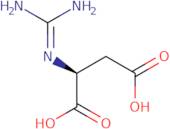Informations sur le produit
- (2S)-2-(Diaminomethylideneamino)butanedioic acid
- <span class="text-smallcaps">L</span>-Aspartic acid, N-(aminoiminomethyl)-
- Aspartic acid, N-amidino-
- Aspartic acid, N-amidino- (7CI)
- Aspartic acid, N-amidino-, <span class="text-smallcaps">L</span>-
- Aspartic acid, N-amidino-, L- (8CI)
- Brn 2098683
- Butanedioic acid, [(aminoiminomethyl)amino]-, (S)-
- L-Aspartic acid, N-(aminoiminomethyl)-
- L-N-Amidinoaspartic acid
- Voir d'autres synonymes
- N-(Aminoiminomethyl)-<span class="text-smallcaps">L</span>-aspartic acid
- N-(Aminoiminomethyl)-L-aspartic acid
- N-(diaminomethylidene)-L-aspartic acid
- N-(diaminomethylidene)aspartic acid
- Nsc 49078
- α-Guanidinosuccinic acid
- Aspartic acid, N-amidino-, L-
Guanidinosuccinic acid is an intermediate in the metabolism of arginine. It is produced from guanidinoacetate by the enzyme arginase and can be converted back to guanidinoacetate by the enzyme argininosuccinase. Guanidinosuccinic acid is found in animal tissues, where it may serve a role as a precursor for creatine synthesis. In humans, it has been detected in lymphocytes, liver cells, and kidney cells. This metabolite also has a physiological function in the body as it regulates metabolism of proteins and nucleic acids. The production of guanidinosuccinic acid can be increased by adding sodium citrate to the culture medium of bacterial strains such as Lactobacillus plantarum. This conversion occurs through a reaction mechanism that involves ATP-dependent transamination or deamination reactions that convert arginine to guanidine and formaldehyde or ammonia. The resultant formaldehyde or ammonia reacts with citrate to





